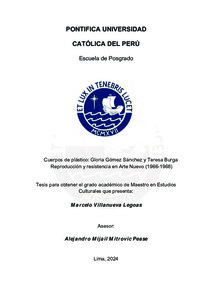| dc.contributor.advisor | Mitrovic Pease, Alejandro Mijail | |
| dc.contributor.author | Villanueva Legoas, Marcelo | |
| dc.date.accessioned | 2024-04-16T19:59:21Z | |
| dc.date.available | 2024-04-16T19:59:21Z | |
| dc.date.created | 2024 | |
| dc.date.issued | 2024-04-16 | |
| dc.identifier.uri | http://hdl.handle.net/20.500.12404/27568 | |
| dc.description.abstract | El objetivo de este trabajo es reflexionar acerca de la producción de tres obras
pop de mediados de los años 60 creadas por las artistas peruanas Gloria Gómez
Sánchez y Teresa Burga. Las piezas que analizaremos en este texto fueron
elaboradas durante su participación como miembros del grupo Arte Nuevo,
vanguardia artística que fue posible gracias al proceso de industrialización y a la
emergente cultura de masas que se estaba desplegando en el Perú de los 60.
La propuesta de estas artistas fue de renovación, pues con sus innovaciones
técnicas el campo artístico se amplió y abrió el camino a nuevas posibilidades
en el mundo del arte. La implementación de nuevos recursos, como materiales
industriales y elementos reciclados catalizaron el propósito de sacar a la luz la
condición de la mujer peruana en el espacio urbano. Muñecones, Corbata y
Objetos fueron las primeras obras que abordaron contenido de género, ya que
hicieron énfasis en las representaciones de la corporalidad femenina. En este
texto, plantearemos una ruta de análisis que considere todas las
determinaciones de estas obras de arte, desde su contenido material hasta su
sentido representacional. Para ello, nos serviremos de los criterios de la Teoría
Social del Arte, en específico, de aquello que proponen Néstor García Canclini y
Mirko Lauer para señalar las determinaciones que permitieron que estas tres
obras existan socialmente. | es_ES |
| dc.description.abstract | The objective of this work is to reflect on the production of three pop works from
the mid-60s created by Peruvian artists Gloria Gómez Sánchez and Teresa
Burga. The pieces that we analyze in this text were made during their participation
as members of the Arte Nuevo group, an artistic avant-garde that was possible
thanks to the industrialization process and the emerging mass culture that was
unfolding in Peru in the 1960s.
The proposal of these artists was one of renewal, because with their technical
innovations the artistic field expanded and opened the way to new possibilities
in the world of art. The implementation of new resources, such as industrial
materials and recycled elements, catalyzed the purpose of bringing to light the
condition of Peruvian women in urban space. Muñecones, Corbata y Objetos
were the first works that addressed gender content, since they emphasized the
representations of female corporality. In this text, we will propose an analysis
route that considers all the determinations of these works of art, from their
material content to their representational meaning. To do this, we will use the
criteria of the Social Theory of Art, specifically, what Néstor García Canclini and
Mirko Lauer propose to point out the determinations that allowed these three
works to exist socially. | es_ES |
| dc.language.iso | spa | es_ES |
| dc.publisher | Pontificia Universidad Católica del Perú | es_ES |
| dc.rights | info:eu-repo/semantics/openAccess | es_ES |
| dc.rights.uri | http://creativecommons.org/licenses/by/2.5/pe/ | * |
| dc.subject | Gómez Sánchez, Gloria | es_ES |
| dc.subject | Burga, Teresa | es_ES |
| dc.subject | Arte pop--Perú | es_ES |
| dc.subject | Vanguardismo (Estética)--Perú | es_ES |
| dc.subject | Industrialización--Perú | es_ES |
| dc.title | Cuerpos de plástico: Gloria Gómez Sánchez y Teresa Burga reproducción y resistencia en Arte Nuevo (1966-1968) | es_ES |
| dc.type | info:eu-repo/semantics/masterThesis | es_ES |
| thesis.degree.name | Maestro en Estudios Culturales | es_ES |
| thesis.degree.level | Maestría | es_ES |
| thesis.degree.grantor | Pontificia Universidad Católica del Perú. Escuela de Posgrado. | es_ES |
| thesis.degree.discipline | Estudios Culturales | es_ES |
| renati.advisor.dni | 45953660 | |
| renati.advisor.orcid | https://orcid.org/0000-0002-9232-5472 | es_ES |
| renati.author.dni | 70450344 | |
| renati.discipline | 314317 | es_ES |
| renati.juror | Hibbett Diez Canseco, Alexandra Imogen | es_ES |
| renati.juror | Mitrovic Pease, Alejandro Mijail | es_ES |
| renati.juror | Curatola Fernandez, Emilia Rosa | es_ES |
| renati.level | https://purl.org/pe-repo/renati/level#maestro | es_ES |
| renati.type | https://purl.org/pe-repo/renati/type#tesis | es_ES |
| dc.publisher.country | PE | es_ES |
| dc.subject.ocde | https://purl.org/pe-repo/ocde/ford#5.04.03 | es_ES |







